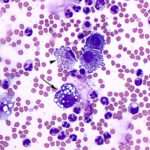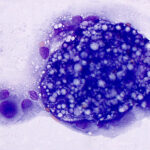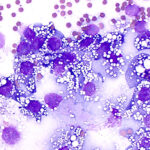Interpretation
Tumor with concurrent hemorrhage and mixed inflammation (neoplastic effusion with exudation, Question 2)
Explanation
The sediment smears contained moderate numbers of individualized and a few unidimensional clusters and flat sheets of medium to large round tumor cells, with increased numbers of non-degenerate neutrophils and fewer macrophages in a bloody background (Figures 3-6, Question 1). The tumor cells had round to oval eccentric nuclei with coarse to ropey chromatin and single to multiple prominent nucleoli, which varied in size and shape. Some nucleoli were quite large. They demonstrated mild to moderate anisocytosis and anisokaryosis and had a moderate amount of deep blue cytoplasm, which was characterized by numerous discrete margined vacuoles, compatible with lipid (Figures 3, 4, 6). Macrophages contained fewer similar vacuoles and some individual cells were difficult to differentiate from tumor cells, unless they demonstrated cytophagic activity. Macrophages with erythrocytes (Figure 5), non-specific debris (Figure 1) and hemosiderin in their cytoplasm were observed. Erythrophagia and hemosiderin indicated concurrent hemorrhage into the pleural cavity. There were low numbers of mesothelial cells (Figure 4, Question 1). Based on the provided location of the mass in the abdomen and the lipid in the tumor cells, a primary ovarian tumor that had metastasized to the thorax was suspected (Question 3).
Additional tests
The abdominal mass was aspirated at the same time as the pleural fluid and direct smears were submitted for evaluation. Examination of modified Wright’s-stained smears of the mass revealed dense circular clusters of tumor cells, which were frequently associated with vascular profiles and aggregates of bland-appearing spindle cells embedded in pink smooth to slightly globular matrix (Figures 7-9). There was also evidence of necrosis, inflammation and hemorrhage. The individual tumor cells had cytologic features similar to that seen in the pleural fluid (Figure 9), indicating that the primary tumor was likely in the abdomen and had metastasized to the mediastinum, lungs and sternal lymph nodes, resulting in a neoplastic and exudative effusion (Question 3). Unfortunately, a definitive diagnosis of an ovarian tumor or the type of tumor was not confirmed as the dog was humanely euthanized and a post-mortem examination was not performed.
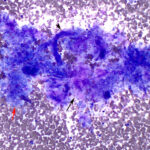 |
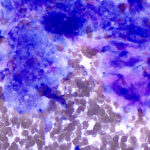 |
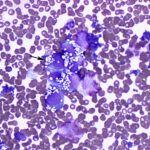 |
Discussion
The ovary consists of a cortex, with developing follicles, and medulla, which contains the neurovascular supply. The cortex is lined by a layer of cuboidal epithelium, which co-expresses vimentin and cytokeratins (pancytokeratin [AE1/AE3] and cytokeratin 7 [CK7]),1 and contains the germ or follicular epithelial cells that produce ova within follicles. As follicles develop, the follicular epithelium becomes multilayered and forms the zona pellucida (glycoprotein-rich), hormone-secreting granulosa (zona granulosa), and outer thecal cell layer. The latter consists of an interna and externa and only becomes visible in secondary follicles. The theca interna contains androgen-hormone secreting cells, whereas the externa contains mesenchymal cells in stroma. Granulosa cells and thecal cells co-operate to form estrogen (thecal cells excrete androgens, which are converted by aromatase to estrogen by the granulosa cells). Granulosa cells also produce progesterone after ovulation. The combined structure of granulosa cells and thecal cells are also called sex cords.2 Since these cells are the source of ovarian hormones, they can contain lipid within their cytoplasm.
Tumors can arise from all aspects of the ovary, including epithelial cells, germ cells, supporting granulosa-theca cells and stromal cells (the latter are often combined as sex cord-stromal tumors).2 They are quite rare, likely due to the practice of early neutering, particularly in the USA. In dogs, the most common tumor types are epithelial tumors and granulosa cell tumors (GCT), with rare germ cell tumors, mixed tumors, primary ovarian sarcomas and metastatic tumors.2,3 Epithelial tumors include adenomas and carcinomas, which arise from the surface epithelium or subsurface epithelial structures (which are only present in bitches) or rete ovarii. They are usually seen in older dogs and can be bilateral. They typically consist of papilliform clusters of relatively uniform cuboidal to columnar epithelial cells on cores of fibrovascular stroma, which can form acinar arrangements.2-6 Diffuse (solid) and tubulopapillary patterns may also be seen and may be difficult to distinguish from sex cord tumors on histologic examination.1,2,4-6 The tumors can be cystic1,2,4-6 and criteria of malignancy include invasion into vessels, surrounding stroma or nearby tissues, large size, and disorganization of clusters.2 Immunohistochemical staining shows that tumor cells are double positive for pancytokeratin and vimentin,1,6 mimicking the staining of the normal ovarian epithelium. Most but not all were positive for CK71,6 and some tumors also stained with antibodies against desmin and placental alkaline phosphatase (4/6 cases), with variable expression of α-fetoprotein and S-100.6 None were positive for inhibin-α, a marker of endocrine-secreting cells of the ovary or sex cord cells (and inhibitor of follicle-stimulating hormone).1,5,6 Another useful marker for ovarian epithelial tumors is Hector Battifora mesothelial epitope-1 (HBME-1), which stains the apical surface of normal and neoplastic ovarian epithelium (17/18 tumors), whereas GCT (10/10) are negative.5
Germ cell tumors consist of dysgerminomas, teratomas and the very rare embryonal carcinomas.2,4 Dysgerminomas are cellular tumors composed of individual round to polyhedral cells, with a few multinucleated cells. The cells have high mitotic activity and resemble seminomas of the canine testes. Infiltrates of small lymphocytes are often seen with the tumor cells.2,3 These tumors occur in older animals and can be malignant with vascular and peritoneal metastasis. In one study, three cases were negative for cytokeratin (pan or CK7), placental alkaline phosphatase, S-100 and inhibin-α but were positive for vimentin. They showed inconsistent reactivity for desmin and α-fetoprotein.6 Teratomas are most commonly seen in dogs and horses and arise from a pluripotential germ cell that differentiates into multiple types of mature tissues, such as cartilage, bone, sebaceous gland and skin. They can be seen in young and older animals and can also be metastatic.2-4
Sex cord-stromal tumors generally include granulosa and granulosa-theca tumors and other endocrine counterparts, such as thecoma and luteoma.2-4 These tumors usually occur in older animals, but can be seen in young animals, and are unilateral or bilateral. Animals can show clinical signs of excess hormone secretion, including persistent heats, feminization and bone marrow aplasia. Of the sex cord tumors, GCTs are the most common type, although many tumors contain multiple types of sex cord cells. Granulosa cell tumors are comprised of round to cuboidal cells with indistinct boundaries that form various histologic patterns, including micro and macrofollicular arrangements, nests, sheets, trabecular to ribbon-like cords (palisading), and diffuse. There are also spindle cell or “Sertoli cell” variants.1,2,4-6 Many tumors will have a supporting stroma containing spindle cells.2,4 In some tumors, the stroma contains cells resembling those of the theca layer, resulting in a diagnosis of granulosa-theca tumor.2 As for ovarian epithelial tumors, sex cord-stromal tumors can be cystic.2,6 Call-Exner bodies (tumor cells arranged around in a circle or rosette around central pink hyaline material) are characteristic of these tumors,2,4 but are not invariably seen, particularly in dogs.1,4,6 Psammoma bodies may be observed in these tumors in cattle.4 Granulosa cell tumors can be benign or malignant; malignant tumors have more cellular atypia, mitoses and disorganization and can metastasize to other organs or cause carcinomatosis.2 Sex cord-stromal tumors, particularly those displaying a diffuse or solid pattern of growth, can be difficult to distinguish from ovarian epithelial tumors by histologic criteria1 and some tumors consist of mixed epithelial and sex cord-stromal component.2,4 Immunohistochemical staining can be helpful, particularly the combination of CK7 (expressed in ovarian epithelial structures; positive and negative reactions for CK7 were used to reclassify tumors as epithelial or GCT, respectively, in one study;1 CK7 was positive in 4/6 carcinomas, but negative in 18 sex cord-stromal tumors and 3 germ cell tumors in another study6) and inhibin-α (positive and negative reactions were used to reclassify GCT and carcinomas in one study, respectively;1 inhibin-α was positive in all 10 GCT, whereas 18/18 carcinomas were negative in another study;5 inhibin-α was positive in 12/18 GCT with cord and spindle cell variants being negative in a third study6). The latter is a marker of developing and mature follicles and the cumulus oophorus.1,5 However, there is overlap between epithelial and sex cord-stromal cell tumors with marker expression, as they can both express pancytokeratin, vimentin, S-100 and desmin,1,6 with granulosa and thecal cells in the normal ovary showing dual reactivity for pancytokeratin and vimentin.1 It should be noted that the overall number of cases in all of these immunohistochemical studies was low (attesting to the rare occurrence of ovarian tumors in dogs).
There are a few cytologic descriptions of normal ovarian tissue3 and tumors in dogs.3,7-13 In a series of 19 cases from Italy, aspirates of ovarian papillary adenomas or adenocarcinomas were characterized by papillary clusters, with some individualized cells, as well as large circular clusters of tumor cells (called “cell balls”).3,7 Tumor cells did exfoliate as individual cells or clusters into effusions and the clusters had the characteristic papillary arrangement and displayed mild anisokaryosis and anisocytosis, but they cannot be conclusively differentiated from carcinomas arising from other sites.7,8,13 Some epithelial cell tumors can contain vacuoles, which can coalesce into a single structure (“signet ring” cells).2-4 In contrast, aspirates from GCT were composed of spindled to round cells that were found in loosely cohesive one-dimensional nests or packets, similar to other endocrine tumors. The tumors showed less cohesion and more indistinct boundaries than papillary adenomas or adenocarcinomas and lacked the 3-dimensional architecture that is more typical of most epithelial tumors. Some clusters were associated with vessels. The cells had a moderate to abundant light blue to eosinophilic cytoplasm that contained cytoplasmic vacuoles, resembling Sertoli cells of the canine testicle.3,7,9 Acinar-like arrangements, some of which had central light pink cores, resembling Call Exner bodies, were seen in some GCT aspirates.3,7 Tumor cells can be associated with streaky to fibrillar pink extracellular matrix.3 There have been no cytologic descriptions of these tumors exfoliating into effusions. Luteomas consist of sheets of large round to polyhedral cells with lightly vesiculated to highly vacuolated cytoplasm and have been seen in a hedgehog9 and cat.11 In the latter case, oil red O staining confirmed the lipid nature of the vacuoles.11 Luteomas arise from granulosa-thecal cells and resemble cells seen in the corpus luteum, which is positive for pancytokeratin and vimentin, but negative for inhibin-α and CK7, in normal ovaries.1 Dysgerminomas consist of large individual round cells, with stippled to coarse chromatin, bi- and multinucleated cells, moderate to marked anisokaryosis and low to moderate numbers of lymphocytes.3,7,9,10 Mixed germ and granulosa cell tumors contain a mixture of cells with features of both tumor types.7 Aspirates of teratomas consist of mixed tissues, such as various types of epithelium (columnar, sebaceous, squamous), along with mixed inflammation and necrosis.3,7,12 Peritoneal fluid from a dog with a malignant teratoma contained individualized and clusters of blue epithelial cells with cytoplasmic vacuoles and individual squamous epithelial cells.12
In this case, we did not confirm the suspected ovarian origin of the tumor or the type of tumor. Considering the young age of the dog, clinical and imaging evidence of excessive reproductive hormone production (abnormal heats, dilated uteri) and the cytologic features of the cells, namely flat one-dimensional sheets or circular clusters with linear arrangements, intracytoplasmic lipid, association with vessels and lack of papillary clusters, a malignant GCT is considered likely. The chunks of stroma with interspersed uniform spindle cells (presumptive fibroblasts) could represent dense stroma seen in more undifferentiated GCTs.4 However, since there are different patterns for carcinomas, including solid or diffuse types, an ovarian carcinoma cannot be ruled out. Although the epithelial cells in the peritoneal fluid from a dog with a malignant teratoma12 somewhat resembled the tumor cells in the pleural fluid of our case, a teratoma was considered less likely based on the lack of mature differentiated tissue in the aspirate.
References
- Riccardi E, et al. Immunohistochemical diagnosis of canine ovarian epithelial and granulosa cell tumors. J Vet Diagn Invest 2007;19:431–5.
- MacLachlan NJ and Kennedy PC. Tumors of the genital system. In Tumors of Domestic Animals, 4th ed; Ed. Meuten DJ. Iowa State University Press, Ames, Iowa, 2002; pp 547-573.
- Solano-Gallego L and Masserdotti C. Reproductive system. In Canine and Feline Cytology – a Color Atlas and Interpretation Guide 3rd ed. Eds Raskin RE and Meyer DJ. Elsevier, St Louis, MO. 2016; pp 313-352.
- Kennedy PC, et al 1998. Histological classification of tumors of the genital system of domestic animals. Armed Forces Institute of Pathology, American Registry of Pathology, Washington, DC.
- Banco B, et al. Canine ovarian tumors: an immunohistochemical study with HBME-1 antibody. J Vet Diagn Invest 2011;23:977–981
- Akihara Y, et al. Immunohistochemical evaluation of canine ovarian tumors. J Vet Med Sci 2007;69:703–708.
- Bertazzolo W, et al. Cytological features of canine ovarian tumours: a retrospective study of 19 cases. J Small Anim Pract 2004;45:539–45.
- Bertazzolo W, et al. Cytologic features and diagnostic accuracy of analysis of effusions for detection of ovarian carcinoma in dogs. Vet Clin Pathol 2012;41:127–32.
- Webb JL, Friedrichs KR. Have you had your pet spayed or neutered? Vet Clin Pathol 2013;42:3.
- Brazzell JL, Borjesson DL. Intra-abdominal mass aspirate from an alopecic dog. Vet Clin Pathol 2006;35:259–62
- Choi US, et al. Intra-abdominal mass aspirate from a cat in heat. Vet Clin Pathol 2005;34:275–7.
- Elena Gorman M, et al. What is your diagnosis? Peritoneal fluid from a 1-year-old female German Shepherd dog. Malignant teratoma. Vet Clin Pathol 2010;39:393–4.
- Salgado BS, et al. What is your diagnosis? Ascites fluid from a dog with abdominal distension. Veto Clin Pathol 2012;41:605–6.
Authored by: T. Stokol and M Forman.

